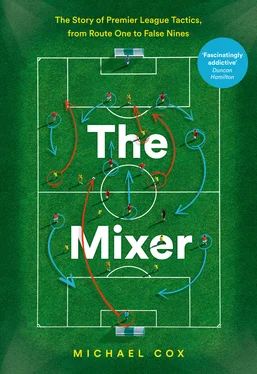Vieira and Petit were outstanding in the second half of the 1997/98 title-winning campaign as a tight partnership that concentrated on ball-winning, although Vieira surged forward sporadically and Petit offered a wonderful passing range with his left foot. With Bergkamp and Wright often injured in the second half of the campaign, Arsenal would depend upon crucial contributions from young reserve strikers Christopher Wreh and Nicolas Anelka, the latter becoming a significant player in the Premier League’s tactical evolution. But the crucial attacker throughout the title run-in was Overmars. Although Arsenal’s formation was 4–4–2, Overmars was allowed freedom to push forward down the left, while Parlour played a narrower, shuttling role on the right. In later days it would be termed a 4–2–3–1, although at the time it was considered a lopsided 4–3–3 in the attacking phase, with Petit shifting across slightly to cover and Parlour tucking inside. Overmars was happy on either foot but primarily right-footed, a goal-scoring threat more than a creator.
Overmars’s attack-minded positioning helped him provide a truly magnificent performance in the 1–0 victory over Manchester United in mid-March that swung the title race in Arsenal’s favour. Almost all Arsenal’s attacking play went through the Dutchman, who handed young United right-back John Curtis, then a promising prospect, an afternoon so difficult that his career never really recovered. In the early stages Overmars collected a through-ball from Bergkamp, rounded Peter Schmeichel and fired narrowly wide from a difficult angle. Shortly afterwards he made another run in behind, and was astonished not to be awarded a penalty after Curtis clearly tripped him. Next he stabbed the ball into the side netting having evaded Curtis and Gary Neville, who started as a right-sided centre-back. Finally, Overmars provided the decisive moment ten minutes from time, when both Bergkamp and Anelka flicked on a long ball, allowing the winger to race through and slip the ball between Schmeichel’s legs.
Considering this was the decisive game of Arsenal’s title-winning campaign, Overmars’s one-man show is among the greatest individual performances that the Premier League has seen. He followed this by scoring two brilliant solo goals in the title-clinching 4–0 victory over Everton at Highbury, then opened the scoring in the 2–0 FA Cup Final win over Newcastle, as Arsenal clinched the double in Wenger’s first full campaign. That victory at Wembley also showed how Wenger was not remotely a reactive manager – he didn’t mention the opposition once before the game, an approach he maintained throughout the majority of the Premier League era.
Such tactical naivety would cost Arsenal in European competition over the following seasons – they didn’t qualify from the group stage during their first two Champions League attempts, and Wenger’s side would later struggle in the Premier League against more tactically astute opposition. Like so many other revolutionaries in the Premier League, the Frenchman was something of a victim of his own success. Other managers soon replicated his approach, particularly in the three areas where he significantly changed English football: improved physical conditioning, recruiting players from abroad and greater emphasis upon technical football. Gradually Wenger’s uniqueness was diminished, but his initial impact was hugely influential, and he summarised it best himself. ‘I felt like I was opening the door to the rest of the world,’ he said. This was the start of the Premier League becoming the world’s most international division.
6
‘Owen was doing things that made me think, “Hang on, if so-and-so was in that position, would he have done that?” And the answer was, “No, he wouldn’t have had the pace.”’
Glenn Hoddle
Number 9s during the Premier League’s formative years were stereotypically tall, strong target men who stationed themselves inside the penalty box and thrived on crosses. Dion Dublin, Duncan Ferguson and Chris Sutton were the classic examples; they could out-muscle and out-jump opposition centre-backs, but rarely threatened to outrun them.
The Premier League’s newfound love of technical football, and its new breed of deep-lying, creative forwards, necessitated a different mould of striker. Increasingly, managers wanted strikers who could sprint in behind the opposition defence to reach clever through-balls between opponents. Gradually, speed replaced aerial power as the most revered attribute up front.
Two of the most memorable Premier League goals in 1997 were solo runs by quick strikers dribbling through the Manchester United defence: Derby County’s Paulo Wanchope in April and Coventry’s Darren Huckerby in December, both in surprise 3–2 wins for the underdogs over the Premier League champions. These goals epitomised the change in the nature of centre-forwards, but the most revolutionary individuals were two teenage prodigies: Arsenal’s Nicolas Anelka and Liverpool’s Michael Owen.
The similarities between Anelka and Owen are striking. Both were born in 1979, made their debuts in the second half of 1996/97, before making a serious impact in 1997/98. That season Anelka lifted the title with Arsenal, while Owen won the Premier League Golden Boot and the PFA Young Player of the Year. The following season Owen retained the Golden Boot, while Anelka finished just one goal behind and succeeded Owen as the Young Player winner – although he courted controversy by going nightclubbing rather than attending the awards ceremony.
When both strikers left the Premier League it was for Real Madrid; Anelka in 1999, Owen five years later, although both lasted just a season in the Spanish capital and played the majority of their career in England. Anelka eventually hit 125 Premier League goals, Owen 150. Both were rather distant, aloof characters, and despite all their achievements, neither are remembered as a legend at any one particular club. The main similarity, though, is simple: they were astonishingly quick. Pace had always been a dangerous weapon in a striker’s armoury. The likes of Andy Cole and Ian Wright – 187 and 113 Premier League goals respectively – were prolific in the Premier League’s first half-decade, and clearly weren’t traditional target men. However, they were primarily finishers who happened to boast a turn of speed. Anelka and Owen were essentially sprinters also capable of scoring, and in an era where centre-backs were built for battles in the air, scored easy goals by exploiting their sluggishness on the ground.
Anelka was a wonderful talent, boasting a sensational mix of speed, trickery and coolness when one-on-one with the goalkeeper. In Premier League terms the Frenchman was a forerunner of compatriot Thierry Henry, a more celebrated player who became an inspiration for the likes of Theo Walcott, Daniel Sturridge, Danny Welbeck and Anthony Martial. That mould of athletic, lightning-quick striker can essentially be traced back to Anelka’s initial impact for Arsenal.
Anelka started his first full season, 1997/98, behind Wright in Arsène Wenger’s pecking order, but had a crucial impact in Arsenal’s double-winning campaign. His first Arsenal goal was the opener against title rivals Manchester United in November 1997, a crucial 3–2 victory, and he ended the season by scoring the second in the 2–0 FA Cup Final triumph over Newcastle. His most typical goal came in a 4–1 victory away at Blackburn Rovers on Easter Monday, when he collected a long chip from Nigel Winterburn, streaked away from the opposition defence, then dummied a shot to put goalkeeper Alan Fettis on the ground, took the ball around him and lifted it past the despairing lunge of a defender into the net. That made it 4–0 before half-time, a typical example of Arsenal’s ability to blitz opponents through speed in the opening stages, and produced a round of applause from mesmerised Blackburn supporters.
Читать дальше












